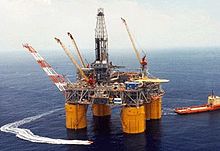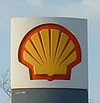
An oil platform is a large structure with facilities to extract and process petroleum and natural gas that lie in rock formations beneath the seabed. Many oil platforms will also have facilities to accommodate the workers, although it is also common to have a separate accommodation platform linked by bridge to the production platform. Most commonly, oil platforms engage in activities on the continental shelf, though they can also be used in lakes, inshore waters, and inland seas. Depending on the circumstances, the platform may be fixed to the ocean floor, consist of an artificial island, or float. In some arrangements the main facility may have storage facilities for the processed oil. Remote subsea wells may also be connected to a platform by flow lines and by umbilical connections. These sub-sea facilities may include one or more subsea wells or manifold centres for multiple wells.

Offshore construction is the installation of structures and facilities in a marine environment, usually for the production and transmission of electricity, oil, gas and other resources. It is also called maritime engineering.
Port Fourchon is Louisiana’s southernmost port, located on the southern tip of Lafourche Parish, on the Gulf of Mexico. It is a seaport, with significant petroleum industry traffic from offshore Gulf oil platforms and drilling rigs as well as the Louisiana Offshore Oil Port pipeline. Fourchon's primary service markets are domestic deepwater oil and gas exploration, drilling, and production in the Gulf. Port Fourchon currently services over 90% of the Gulf of Mexico's deepwater oil production. There are over 600 oil platforms within a 40-mile radius of Port Fourchon. This area furnishes 16 to 18 percent of the US oil supply.

A floating production storage and offloading (FPSO) unit is a floating vessel used by the offshore oil and gas industry for the production and processing of hydrocarbons, and for the storage of oil. An FPSO vessel is designed to receive hydrocarbons produced by itself or from nearby platforms or subsea template, process them, and store oil until it can be offloaded onto a tanker or, less frequently, transported through a pipeline. FPSOs are preferred in frontier offshore regions as they are easy to install, and do not require a local pipeline infrastructure to export oil. FPSOs can be a conversion of an oil tanker or can be a vessel built specially for the application. A vessel used only to store oil is referred to as a floating storage and offloading (FSO) vessel.

A tension-leg platform (TLP) or extended tension leg platform (ETLP) is a vertically moored floating structure normally used for the offshore production of oil or gas, and is particularly suited for water depths greater than 300 metres and less than 1500 metres. Use of tension-leg platforms has also been proposed for offshore wind turbines.
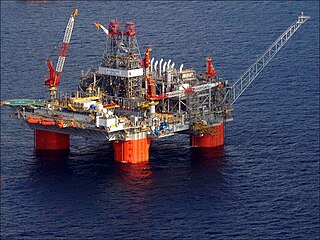
Thunder Horse oil field is a large offshore deepwater oil field in the Gulf of Mexico, around 150 miles (240 km) southeast of New Orleans, Louisiana. Large new oil discoveries within it were announced in early 2019.
The economic effects of Hurricane Katrina, which hit Louisiana, Florida, Texas and Mississippi in late August 2005, were far-reaching.

Magnolia is an offshore oil drilling and production Extended Tension Leg Platform in the Gulf of Mexico. It was the world's deepest ETLP, reaching 1,432 m (4,698 ft), beating the Marco Polo TLP by 120 m (390 ft). In March 2018, Big Foot ETLP took over this claim in 1,580 m (5,180 ft).
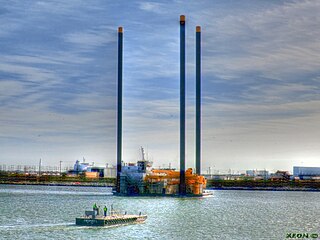
A liftboat is a self-propelled, self-elevating vessel used in support of various offshore mineral exploration and production or offshore construction activities. A liftboat has a relatively large open deck to accommodate equipment and supplies, and the capability of raising its hull clear of the water on its own legs so as to provide a stable platform from which maintenance and construction work may be conducted.

Mad Dog Oil Field is an offshore oil field located along the Sigsbee Escarpment at Green Canyon blocks 825, 826 and 782, Western Atwater Foldbelt, Gulf of Mexico. The field is located about 190 miles (310 km) south of New Orleans and 150 miles (240 km) southwest of Venice, Louisiana, United States. It is in the depth of 5,000 to 7,000 feet of water.
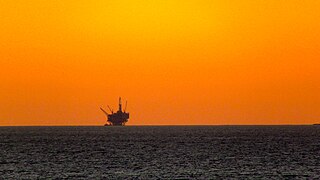
Offshore drilling is a mechanical process where a wellbore is drilled below the seabed. It is typically carried out in order to explore for and subsequently extract petroleum that lies in rock formations beneath the seabed. Most commonly, the term is used to describe drilling activities on the continental shelf, though the term can also be applied to drilling in lakes, inshore waters and inland seas.
Deepwater drilling, or deep well drilling, is the process of creating holes in the Earth's crust using a drilling rig for oil extraction under the deep sea. There are approximately 3400 deepwater wells in the Gulf of Mexico with depths greater than 150 meters.
The Hutton oil field, located on the UK continental shelf, was the location for the first ever production Tension Leg Platform (TLP).

Offshore oil and gas in the Gulf of Mexico is a major source of oil and natural gas in the United States. The western and central Gulf of Mexico, which includes offshore Texas, Louisiana, Mississippi, and Alabama, is one of the major petroleum-producing areas of the United States. Oil production from US federal waters in the Gulf of Mexico reached an all-time annual high of 1.65 million barrels per day in 2017. Oil production is expected to continue the upward trend in 2018 and 2019, based on ten new oil fields which are planned to start production in those years. According to the Energy Information Administration, "Gulf of Mexico federal offshore oil production accounts for 15% of total U.S. crude oil production and federal offshore natural gas production in the Gulf accounts for 5% of total U.S. dry production."
Gunashli is an offshore oil field in the Caspian Sea, located 120 kilometres (75 mi) east of Baku, Azerbaijan, 12 kilometres (7.5 mi) southeast of Oil Rocks and its deep water section is a part of the larger Azeri–Chirag–Gunashli (ACG) project. The Azerbaijani translation of Gunashli means "sunny". Gunashli is believed to have more than 100 million tonnes of oil reserves.
The Macondo Prospect is an oil and gas prospect in the United States Exclusive Economic Zone of the Gulf of Mexico, off the coast of Louisiana. The prospect was the site of the Deepwater Horizon drilling rig explosion in April 2010 that led to a major oil spill in the region from the first exploration well, named itself MC252-1, which had been designed to investigate the existence of the prospect.

Deepwater Nautilus is an ultra-deepwater, semi-submersible offshore drilling rig.
A steel catenary riser (SCR) is a common method of connecting a subsea pipeline to a deepwater floating or fixed oil production platform. SCRs are used to transfer fluids like oil, gas, injection water, etc. between the platforms and the pipelines.
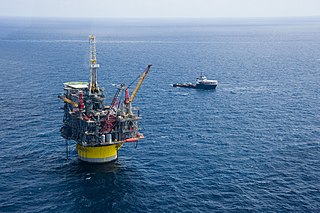
Perdido (Spanish for lost) is the deepest floating oil platform in the world at a water depth of about 2,450 meters (8,040 feet) operated by the Shell Oil Company in the Gulf of Mexico. The platform is located in the Perdido fold belt which is a rich discovery of crude oil and natural gas. The Perdido spar began production in 2010 and its peak production is 100,000 barrels of oil equivalent (c. 16000 m3/d) and 200 million cubic feet of gas per day (c. 5.7×106 m3/d).
Olympus is a tension leg platform oil rig, planned as a further development of the Mars field.
